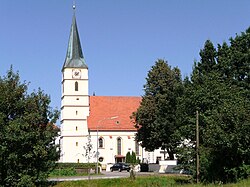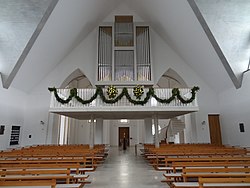St. John the Baptist (Bodenkirchen)
The Roman Catholic parish church of St. John the Baptist in Bodenkirchen , a village in the Lower Bavarian district of Landshut , is a late Gothic building from around 1500 with a modern extension from the 1960s. The patron saint of the church is St. John the Baptist (Memorial Day: June 24th).
history
The parish church of St. John the Baptist in Bodenkirchen could go back to one of the oldest aristocratic own churches in the Bina valley and thus date from the 8th or 9th century. However, this is not certain and is based, among other things, on the ending of the place name in "-kirchen". At that time there were also aristocratic own churches in Dietelskirchen, Haberskirchen, Hinterskirchen, Leberskirchen, Loizenkirchen, Wendelskirchen or Westerskirchen - all in the Vilstal and the surrounding area. In the second half of the 12th century, the local nobleman Wolfram has been handed down by pubic churches .
In 1219 the church of Bodenkirchen is mentioned for the first time in a document .
The old building of the parish church of St. John the Baptist was built around 1500 in the late Gothic style. At that time Bodenkirchen was a branch church of St. Ulrich in Aich ; In the branch there was a benefit in honor of the Blessed Virgin Mary . At that time Bodenkirchen was known as Ponkhürchen . Before 1724 Bodenkirchen was raised to the position of Expositur and thus had the right to its own pastor . But it wasn't until about 200 years later, on March 14, 1921, that Bodenkirchen received parish rights from Regensburg Bishop Anton von Henle due to the rapidly growing population . Michael Gretzinger, who had been appointed here since 1915, became the first pastor on November 1, 1921.
The two-storey sacristy , which is attached to the south of the old building, was built in 1700 by Dominikus Christoph Zuccalli for 398 guilders . In 1930 the parsonage was rebuilt in a different location, in the north of the street village , due to an expansion of the cemetery . Due to the renewed population growth and the economic boom in the 1950s and 1960s, an expansion of the existing parish church was urgently needed. After the cemetery expansion and the relocation of graves began in 1962, the church administration under Pastor Franz Pickl finally decided in January 1964 that the parish church should be expanded to the north.
According to the plans of the Munich architect Friedrich Ferdinand Haindl , a drastic expansion of the old building took place between 1965 and 1967. The furnishings for the extension were made by the sculptor Hans Wurmer from Hausen in the Kelheim district . On March 5, 1967, the Regensburg auxiliary bishop Josef Hiltl was able to consecrate the church . The total costs for the new building amounted to 966,000 D-Marks . After the construction of the new building, the neo-Gothic furnishings in the old building - altars, figures and glass windows - were removed.
In 1991 and 1992, concrete renovation had to be carried out in the outdoor area. The old building and the tower were also renovated. Since 1996 the parish of Bodenkirchen has been part of a parish community with Bonbruck. In April 2011, after a two-year planning period, architect Franz Steinberger from Munich and pastor Clemens Voss began a comprehensive interior renovation of the parish church. This included the construction of a new organ gallery , the reorganization of the old Gothic church, in particular the redesign of the Gothic choir into a weekday chapel, the enlargement of the new sacristy, the installation of bench heating instead of the old oil heating and the installation of a modern confessional in the old boiler room. On 18 March 2012, was made consecration of people's altar and ambo of the new weekday chapel by Bishop Gerhard Ludwig Müller .
In 2015 it was finally decided to have the old, caseless organ from 1979, which was also of poor quality, replaced by a new one by Thomas Jann as Allkofen near Laberweinting . The new instrument was in a solemn Mass by Bishop on October 9, 2016 Voderholzer Rudolf dedicated to be.
architecture
The late Gothic old building comprises a three-bay nave and a two-bay choir, closed on three octagonal sides, facing east. The five-storey tower of unequal height is built on the west side. It is likely to be the oldest part of the building in the church; possibly it even goes back to the Romanesque period. In the neo-Gothic style, a pointed helmet was put on as the top of the tower in place of the earlier gable roof . The two-storey sacristy extension from 1700 is located on the south side. The only portal into the old building can be found in the middle nave yoke on the south side .
Three ogival openings on the north wall of the Gothic church serve as a transition to the new building . From there, a modern church room 22 meters long and 16.5 meters wide extends to the north. Typical of the architect Haindl is the character of the “tent of God among the people”. The extension made of concrete has two high, pointed window openings to the east and west, which are intended to be reminiscent of Gothic pointed arch windows. On the northern front, where the altar area rises up by four steps, there are two similar windows; above it a small square roof turret with a pyramid helmet . Access to the extension is via the portal on the west side. The modern sacristy is built in the east.
During the renovation in 2011/12, the Gothic font was placed in the axis cross of the two church rooms. Otherwise the nave of the old building is empty today. The Gothic choir was converted into a weekday chapel during the aforementioned renovation. It was separated from the nave of the old building with a shiny golden brass mesh , which can also be found as the background of the bronze cross in the altar area of the new church.
Furnishing
As is typical for modern churches, the furnishings are sparse and simple. In addition, the sacred space was set up according to the requirements of the Second Vatican Council . The people's altar, the ambo, the bronze cross and the figure of the Mother of God, which is placed to the right of the altar area, were created by Hans Wurmer from Kelheim marble. The Way of the Cross , which only came into the church in 1979, and a bronze relief plaque on the cemetery wall , on which the baptism of Jesus by John the Baptist is shown , also come from Wurmer .
organ
As a replacement for an instrument from 1979, the parish church received a new organ in 2016 from Thomas Jann from Allkofen in the Straubing-Bogen district . The slider chest instrument with mechanical performance and stop actions comprises a total of 22 stops on two manuals and pedal . Instead of the usual manual coupler, the first manual was built into the three-manual console as a coupler manual . In order to be able to adequately fill the rear area of the church, in which the baptismal and weekday chapel are located, the swell was given a second blind front and a separate, single-manual console . The disposition of the organ is as follows:
|
|
|
|||||||||||||||||||||||||||||||||||||||||||||||||||||||||||||||||||||||||||||||||||||||||||||||||
- Pairing: I / P, II / P
- Playing aids : wind reduction for sub-bass 16 '
- Remarks:
- ↑ No independent register, but wind weakening from sub-bass 16 ′
- * = Register can be played from the second gaming table
Bells
Three bells ring in the tower, only one of which survived the Second World War . This is from 1877. The other two bells were replaced in 1949.
Surroundings
To the south and south-east of the parish church of St. John the Baptist is the cemetery of the parish of Bodenkirchen.
literature
- Georg Schwarz, Wolfgang Mandl, Gerhard Stadlbauer: The upper Bina valley between the rivers Vils and Rott . Published by the cath. Pfarramt Bonbruck, 1994. pp. 45-50.
Web links
Individual evidence
- ↑ a b c d e f g Schwarz, Mandl, Stadlbauer; Pp. 45-50.
- ↑ Peter Käser: History of Aich . Online at www.bodenkirchen.com; accessed on December 27, 2016 (PDF; 913 kB)
- ↑ a b c Parish Church of St. John the Baptist Bodenkirchen . Online at www.pfarrei-bodenkirchen-bonbruck.de; Retrieved December 25, 2016.
- ↑ Churches . Online at www.pfarrei-bodenkirchen-bonbruck.de; Retrieved December 25, 2016.
- ↑ a b Parish letter of the parish community Bodenkirchen-Bonbruck, No. 17-2016, October 8-23, 2016.
- ^ Organ consecration: A new "queen of instruments" for Bodenkirchen . Online at www.bistum-regensburg.de; accessed on February 11, 2017.
- ↑ Bodenkirchen, St. John the Baptist . Online at www.jannorgelbau.com; accessed on February 11, 2017.
- ↑ Bodenkirchen, St. John the Baptist - Disposition . Online at www.jannorgelbau.com; accessed on February 11, 2017.
Coordinates: 48 ° 23 '2.5 " N , 12 ° 23' 17.5" E



